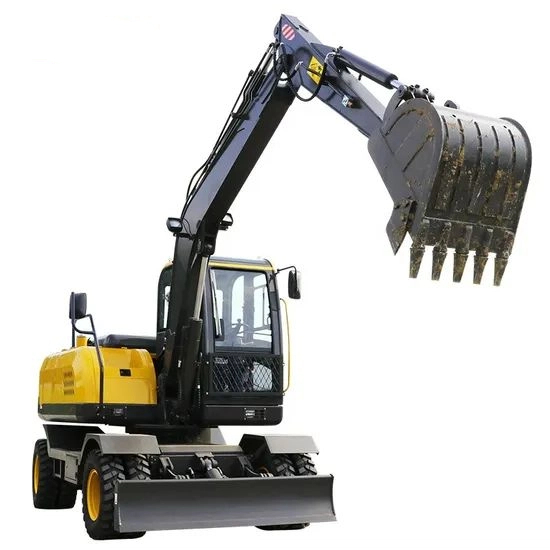"Wheel excavator", namely wheeled excavator, is a type in the excavator family that uses tires as the traveling device. With its flexible transfer and road adaptability, it is widely applied in municipal, highway and other scenarios. The following is a detailed analysis from aspects such as definition, characteristics, applications, and comparison with crawler types:

- Definition: A wheeled excavator is an earth-moving machinery that travels on a tire chassis. It completes excavation and loading operations by driving components such as the bucket and boom through a hydraulic system, and has the ability to drive on highways.
- Core Structure:
- Traveling System: Composed of a drive axle, steering axle, and tires (mostly off-road tires). Some models support all-wheel drive or crab steering (four-wheel independent steering for lateral movement).
- Working Equipment: Similar to crawler types, including the bucket, boom, and stick, but some models adopt lightweight structural designs to reduce weight.
| Dimension | Wheeled Excavator | Crawler Excavator |
|---|
| Moving Speed | Highway speed 可达 20-40km/h, no flatbed truck needed for transfer | Speed only 5-10km/h, transport vehicles required for long-distance transfer |
| Terrain Adaptability | Suitable for hard surfaces (highways, urban roads); easy to slip on muddy/soft terrain | Small crawler ground pressure, strong cross-country ability, suitable for complex terrains |
| Flexibility | Small turning radius, can turn in place, suitable for narrow-space operations | Requires larger space for turning, poor flexibility |
| Weight & Fuel Consumption | Lighter overall weight (10%-20% lighter than crawler types of the same tonnage), lower fuel consumption | Heavy weight, high fuel consumption |
| Road Protection | Tires cause minimal road damage, suitable for municipal projects | Crawlers easily damage asphalt/concrete roads, need steel plates for protection |
- Scenarios: Pipeline excavation (e.g., water supply, gas pipelines), streetlight foundation construction, construction waste clearance.
- Advantages: No frequent transfer transportation needed, can directly drive on urban roads, and has minimal impact on surrounding roads and buildings during operations.
- Scenarios: Highway slope trimming, drainage ditch excavation, emergency rescue (e.g., landslide clearance).
- Case: In highway construction, wheeled excavators can quickly reach the work site to complete shoulder reinforcement or small earthwork projects.
- Scenarios: Orchard fertilization pit digging, small farmland renovation, material loading/unloading in sand yards/material yards.
- Advantages: Flexible body, can drive on field roads, and has higher loading/unloading efficiency than small crawler equipment.
- Narrow-space operations: Such as basement construction in residential areas or interior factory construction. Some models are less than 2.5 meters wide and can pass through standard door frames.
- Multi-mode steering: Supports front-wheel steering, all-wheel steering, and crab steering. For example, the German Liebherr A910 model with crab steering allows the entire machine to move laterally, adapting to complex positions like corners.
- Load-sensitive hydraulic system: Automatically adjusts flow according to operational load, reducing energy loss and lowering fuel consumption by over 15% compared to traditional models.
- Hybrid power technology: Some high-end models (e.g., Volvo EW180E) are equipped with diesel-electric hybrid systems, which can switch to electric mode for urban operations to reduce noise and emissions.
- GPS positioning and automatic leveling: Used for highway subgrade leveling with an accuracy of ±3cm, reducing manual measurement errors.
- Select configurations based on operation scenarios:
- For municipal projects, prioritize models with breaker pipe lines and crab steering functions; for highway maintenance, choose models with high-speed driving (≥30km/h).
- Focus on chassis durability:
- Check if the axle is reinforced (e.g., Meichi axle) and tire specifications (e.g., 14.00R24 off-road tires are more suitable for complex roads).
- Tire maintenance: Regularly check tire pressure (standard pressure 0.3-0.4MPa), avoid driving on sharp objects, and rotate tire positions every 500 hours to balance wear.
- Steering system lubrication: Lubricate steering ball joints, tie rods, and other joints with grease every 200 hours to prevent abnormal noise and (jamming).
- Hydraulic system cleaning: In urban operations with high dust, replace hydraulic oil filters every 1,000 hours to avoid valve blockage by impurities.






